Small overlap front: driver-side
Rating applies to 2016-25 models
Tested vehicle: 2016 Chevrolet Malibu LS 4-door
The Chevrolet Malibu was redesigned for the 2016 model year. The earlier design remained in production for 2016, available new only to fleet buyers, and was called the Chevrolet Malibu Limited. The ratings on this page do not apply to the Malibu Limited.
| Evaluation criteria | Rating |
|---|---|
| Structure and safety cage | |
| Driver injury measures | |
| Head/neck | |
| Chest | |
| Hip/thigh | |
| Lower leg/foot | |
| Driver restraints and dummy kinematics | |
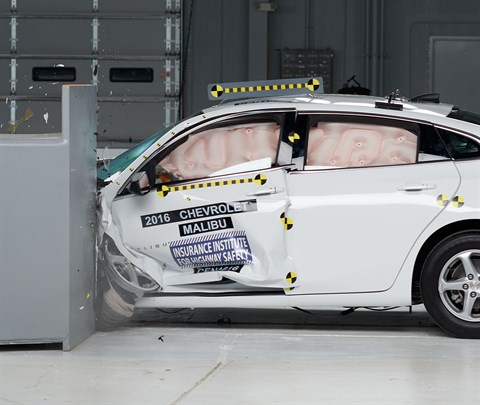
Action shot taken during the driver-side small overlap frontal crash test.
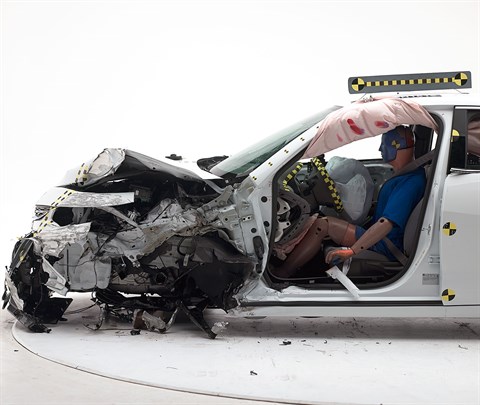
The dummy's position in relation to the door frame, steering wheel, and instrument panel after the crash test indicates that the driver's survival space was maintained well.
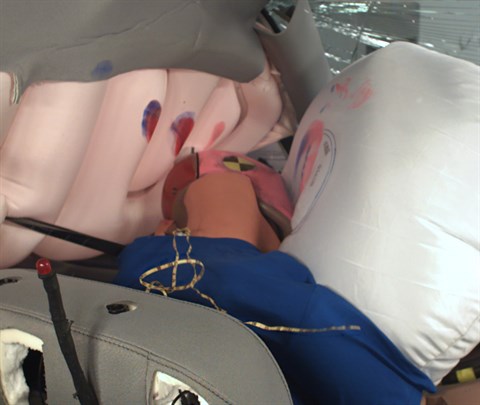
The dummy’s head contacted the frontal airbag but rolled around the left side, allowing the head to move toward the gap in coverage between the frontal and side curtain airbags.
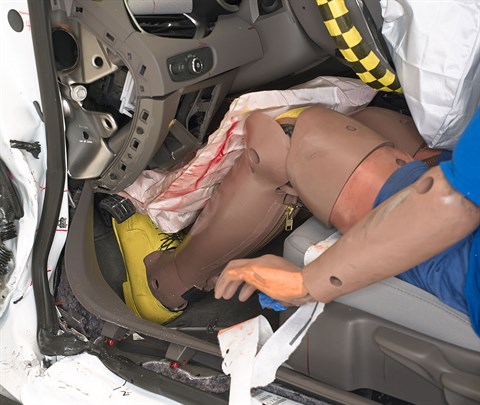
The driver's space was maintained well, and risk of injuries to the dummy's legs and feet was low.
Moderate overlap front: original test
Rating applies to 2016-25 models
Tested vehicle: 2016 Chevrolet Malibu 2LT 4-door
The Chevrolet Malibu was redesigned for the 2016 model year. Moderate overlap frontal ratings are assigned by the Institute based on a test conducted by General Motors.
The earlier design remained in production for 2016, available new only to fleet buyers, and was called the Chevrolet Malibu Limited. The ratings on this page do not apply to the Malibu Limited.
| Evaluation criteria | Rating |
|---|---|
| Overall evaluation | |
| Structure and safety cage | |
| Driver injury measures | |
| Head/neck | |
| Chest | |
| Leg/foot, left | |
| Leg/foot, right | |
| Driver restraints and dummy kinematics | |
Side: original test
Rating applies to 2016-25 models
Tested vehicle: 2016 Chevrolet Malibu 1LT 4-door
The Chevrolet Malibu was redesigned for the 2016 model year. Side ratings are assigned by the Institute based on a test conducted by General Motors.
The earlier design remained in production for 2016, available new only to fleet buyers, and was called the Chevrolet Malibu Limited. The ratings on this page do not apply to the Malibu Limited.
| Evaluation criteria | Rating |
|---|---|
| Overall evaluation | |
| Structure and safety cage | |
| Driver injury measures | |
| Head/neck | |
| Torso | |
| Pelvis/leg | |
| Driver head protection | |
| Rear passenger injury measures | |
| Head/neck | |
| Torso | |
| Pelvis/leg | |
| Rear passenger head protection | |
Side: updated test
Rating applies to 2016-25 models
Tested vehicle: 2022 Chevrolet Malibu LT 4-door
The Chevrolet Malibu was redesigned for the 2016 model year. The earlier design remained in production for 2016, available new only to fleet buyers, and was called the Chevrolet Malibu Limited. The ratings on this page do not apply to the Malibu Limited.
| Evaluation criteria | Rating |
|---|---|
| Overall evaluation | |
| Structure and safety cage | |
| Driver injury measures | |
| Head/neck | |
| Torso | |
| Pelvis | |
|
Driver head protection
The dummy's head moved downward past the side curtain airbag and struck the window sill of the driver door hard. The head protection is inadequate. | |
| Rear passenger injury measures | |
| Head/neck | |
| Torso | |
| Pelvis | |
|
Rear passenger head protection
The dummy's head moved downward past the side curtain airbag and struck the window sill of the rear passenger door hard. The head protection is inadequate. | |
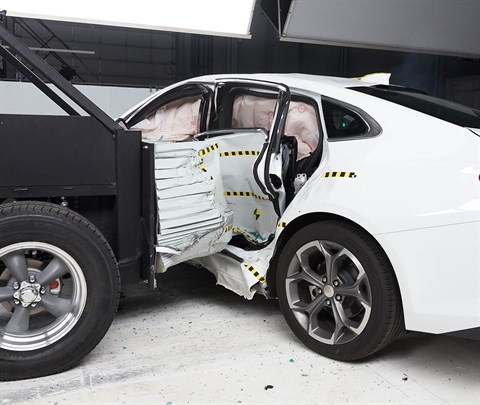
View of the vehicle just after the crash test.
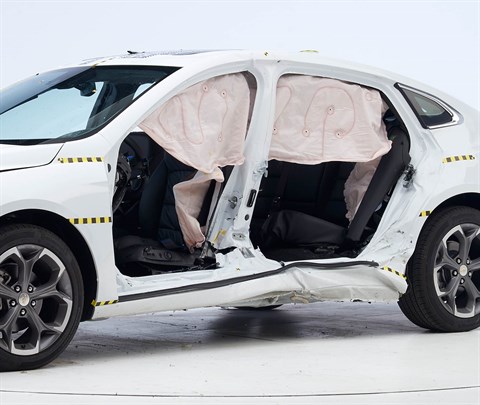
View of the vehicle after the crash with doors removed, showing the side airbags and damage to the occupant compartment.
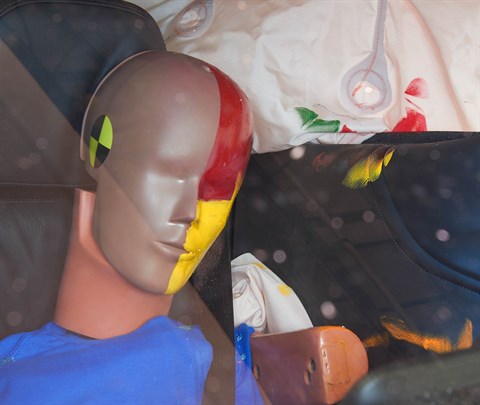
Smeared greasepaint shows that the driver dummy's head moved downward, past the side curtain airbag, and contacted the window sill.

Smeared greasepaint shows that the rear passenger dummy's head moved downward, past the side curtain airbag, and contacted the rear window sill.
Roof strength
Rating applies to 2016-23 models
Tested vehicle: 2016 Chevrolet Malibu 1LT 4-door
| Overall evaluation | |
|---|---|
| Curb weight | 3,117 lbs |
| Peak force | 16,665 lbs |
| Strength-to-weight ratio | 5.35 |
Head restraints & seats
Seat type: Power cloth seat
| Overall evaluation | |
|---|---|
| Dynamic rating | |
| Seat/head restraint geometry |
About the head restraint & seat test
Currently, IIHS tests apply only to front seats.
Headlights
Trim level(s)
- LS trim
- RS trim
- 1LT trim
| Evaluation criteria | Rating |
|---|---|
| Low-beam headlight type | Halogen projector |
| High-beam headlight type | Halogen reflector |
| Curve-adaptive? | No |
| High-beam assist? | Yes |
|
Overall rating | |
| Distance at which headlights provide at least 5 lux illumination: | |
Low beams
On the straightaway, visibility was fair on the right side of the road and inadequate on the left side. On curves, visibility was inadequate in all 4 tests.
The low beams never exceeded glare limits.
High beams
On the straightaway, visibility was good on both sides of the road. On curves, visibility was inadequate in all 4 tests.
High-beam assist compensates for some limitations of this vehicle's low beams on the straightaway and all 4 curves.
Front crash prevention: vehicle-to-vehicle
Ratings are given for 2 different trim variations available on this vehicle.
Front crash prevention: pedestrian (day)
Ratings are given for 2 different systems available on this vehicle.
Front crash prevention: pedestrian (night)
Seat belt reminders
Rating applies to 2022-23 models
| Evaluation criteria | Rating |
|---|---|
| Overall evaluation | |
| Front row | |
| Unbelted occupant alert (audible & visual) | |
| Initiation time | |
| Duration | Negligible (under 8 seconds) |
| Volume | |
| Audio frequency | |
| Second row | |
| Startup status alert (visual) | None |
Child seat anchors
Rating applies to 2016-25 models
| Evaluation criteria | Rating |
|---|---|
| Overall evaluation | |
| Vehicle trim | LS |
| Seat type | cloth |
This vehicle has 2 rear seating positions with complete child seat attachment (LATCH) hardware.
It has 1 additional seating position with a tether anchor only.
| Evaluation criteria | Rating |
|---|---|
| Overall evaluation | |
| Vehicle trim | LS |
| Seat type | cloth |
| Rating icon | Rating |
|---|---|
| G | Good |
| A | Acceptable |
| M | Marginal |
| P | Poor |
| Seating positions that rely on borrowed lower anchors or have only a tether anchor available are not rated. | |
thether anchor symbol | Tether anchor |
lower anchor symbol | Lower anchors |
| Lower anchor(s) can be borrowed from adjacent positions(s) | |
| No hardware available |
Details by seating position
| Position | Rating |
|---|---|
| 1 | |
| Tether anchor | |
| easy-to-find location | |
| no other hardware could be confused for anchor | |
| Lower anchors | |
| too deep in seat | |
| too much force needed to attach | |
| easy to maneuver around anchors | |
| 2 | |
| Tether anchor | |
| easy-to-find location | |
| no other hardware could be confused for anchor | |
| Lower anchors | |
| none available | |
| 3 | |
| Tether anchor | |
| easy-to-find location | |
| no other hardware could be confused for anchor | |
| Lower anchors | |
| too deep in seat | |
| too much force needed to attach | |
| easy to maneuver around anchors |
Rating applies to 2016-25 models
| Evaluation criteria | Rating |
|---|---|
| Overall evaluation | |
| Vehicle trim | LT |
| Seat type | cloth |
This vehicle has 2 rear seating positions with complete child seat attachment (LATCH) hardware.
It has 1 additional seating position with a tether anchor only.
| Evaluation criteria | Rating |
|---|---|
| Overall evaluation | |
| Vehicle trim | LT |
| Seat type | cloth |
| Rating icon | Rating |
|---|---|
| G | Good |
| A | Acceptable |
| M | Marginal |
| P | Poor |
| Seating positions that rely on borrowed lower anchors or have only a tether anchor available are not rated. | |
thether anchor symbol | Tether anchor |
lower anchor symbol | Lower anchors |
| Lower anchor(s) can be borrowed from adjacent positions(s) | |
| No hardware available |
Details by seating position
| Position | Rating |
|---|---|
| 1 | |
| Tether anchor | |
| easy-to-find location | |
| no other hardware could be confused for anchor | |
| Lower anchors | |
| too deep in seat | |
| too much force needed to attach | |
| easy to maneuver around anchors | |
| 2 | |
| Tether anchor | |
| easy-to-find location | |
| no other hardware could be confused for anchor | |
| Lower anchors | |
| none available | |
| 3 | |
| Tether anchor | |
| easy-to-find location | |
| no other hardware could be confused for anchor | |
| Lower anchors | |
| too deep in seat | |
| too much force needed to attach | |
| easy to maneuver around anchors |
